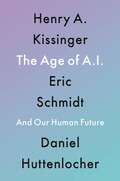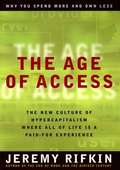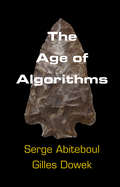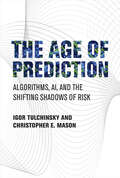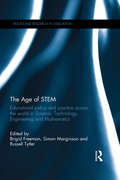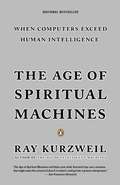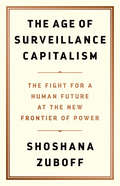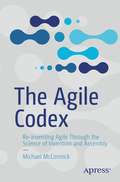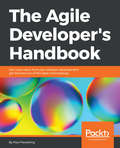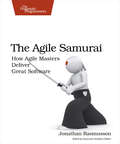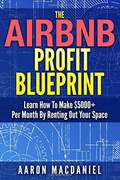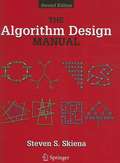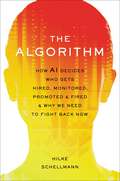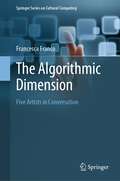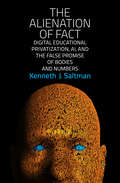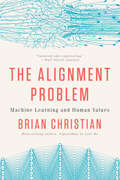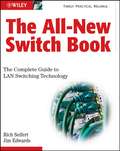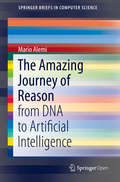- Table View
- List View
The Age of AI: And Our Human Future
by Eric Schmidt Henry A Kissinger Daniel HuttenlocherThree of the world&’s most accomplished and deep thinkers come together to explore Artificial Intelligence (AI) and the way it is transforming human society—and what this technology means for us all. An AI learned to win chess by making moves human grand masters had never conceived. Another AI discovered a new antibiotic by analyzing molecular properties human scientists did not understand. Now, AI-powered jets are defeating experienced human pilots in simulated dogfights. AI is coming online in searching, streaming, medicine, education, and many other fields and, in so doing, transforming how humans are experiencing reality.In The Age of AI, three leading thinkers have come together to consider how AI will change our relationships with knowledge, politics, and the societies in which we live. The Age of AI is an essential roadmap to our present and our future, an era unlike any that has come before.
The Age of AI: Artificial Intelligence and the Future of Humanity
by Jason ThackerAre robots going to take my job? How are smartphones affecting my kids? Do I need to worry about privacy when I get online or ask Siri for directions? Whatever questions you have about AI, The Age of AI gives you insights on how to navigate this brand-new world as you apply God's ageless truths to your life and future.We interact with artificial intelligence, or AI, nearly every moment of the day without knowing it. From our social media feeds to our smart thermostats and Alexa and Google Home, AI is everywhere--but how is it shaping our world?In The Age of AI, Jason Thacker, associate research fellow at the Ethics and Religious Liberty Commission, helps us navigate our digital age in this thoughtful exploration of the social, moral, and ethical challenges of our ongoing interactions with artificial intelligence.Applying God's Word to this new AI-empowered age, Thacker sheds light on:How Christian truth transforms the way we use AIHow AI affects us individually, in our relationships, and in our society at largeHow to navigate the digital age wiselyWith theological depth and a wide awareness of the current trends in AI, Jason is a steady guide who reminds us that while technology is changing the world, it can't shake the foundations of the Christian faith.Praise for The Age of AI:"The Age of AI informs us and assists us in envisioning a future that is filled with tools, influences, opportunities, and challenges relating to artificial intelligence. While many may fear the unknown future before us, Jason Thacker presents the imperative need to always lift up the constancy of the image of God and the dignity of all human life as presented in the Holy Scriptures, the Bible. I am thankful Jason's book can help churches, pastors, theologians, and Christian leaders in all vocations to wrestle through this current topic, always being committed to what this book states profoundly: God-given dignity isn't ours to assign or remove."--Dr. Ronnie Floyd, president and CEO, Southern Baptist Convention Executive Committee
The Age of Access: The New Culture of Hypercapitalism, Where all of Life is a Paid-For Experience
by Jeremy RifkinWe are in the midst of a new age in which "concepts, ideas and images--not things--are the real items of value" and where "the purchase of lived experiences becomes the consummate commodity Today's companies avoid amassing physical capital, which can later prove "an albatross" that prevents them from keeping up with rapid technological advances. Instead, they prefer to "outsource ownership," contracting third parties to provide and maintain equipment. This trend combines with others, such as the proliferation of service relationships, to put more emphasis on access than ownership, heralding a time when what companies sell will be human experience itself and all cultural activities will be commodified.
The Age of Algorithms
by Gilles Dowek Serge AbiteboulAlgorithms are probably the most sophisticated tools that people have had at their disposal since the beginnings of human history. They have transformed science, industry, society. They upset the concepts of work, property, government, private life, even humanity. Going easily from one extreme to the other, we rejoice that they make life easier for us, but fear that they will enslave us. To get beyond this vision of good vs evil, this book takes a new look at our time, the age of algorithms. Creations of the human spirit, algorithms are what we made them. And they will be what we want them to be: it's up to us to choose the world we want to live in.
The Age of Decentralization: How Web3 and Related Technologies will change Industries and our Lives
by Sam Ghosh Subhasis GoraiThe Age of Decentralization talks about various decentralization technologies including Web3, decentralized identity, and decentralized storage, and how they can be incorporated in traditional tech architectures to improve technical and business performance. In this book, the authors take us on a journey through the tech landscape, exploring how decentralized technologies, including Web3, are on the verge of becoming mainstream and offer a practical roadmap for understanding and embracing this shift. Web2 brought us "the great centralization" by centralizing not only data but also business processes, blurring the industry boundaries. So, payment platforms started offering e-commerce services and ride-hailing services started delivering food. Scale became the most effective moat. But, at the same time, these huge platforms became a magnet for security threats and started violating user privacy rights and consumer rights. The authors argue that the technological, regulatory, and social landscape is ready for the next evolution of technology systems as decentralization technologies get incorporated into traditional architectures. This book serves as a guide for readers to understand the fundamentals of Web3 along with other decentralized technologies and creates a framework for incorporating them into traditional architectures. At the same time, the authors explore the organization level as well as the macro implications of decentralized technologies.
The Age of Influence: The Power of Influencers to Elevate Your Brand
by Neal SchafferThe Age of Influence is an essential guide for marketing professionals and business owners who want to create and implement a highly effective, sustainable influencer marketing plan in order for their brands to succeed.We are amid an unprecedented digital transformation and tapping into this change is vital to any brand in today&’s climate. Social media has democratized authority and influence, and information is created and consumed in ways that are constantly evolving.Internationally-recognized social media marketing expert Neal Schaffer explains how that shift plays a significant role in online marketing in the Influencer Era. Influencer marketing is about establishing relationships, turning fans into influencers, and leveraging that influence to share your message in a credible and authentic way.In The Age of Influence, Schaffer teaches entrepreneurs, marketing executives, and cutting-edge agencies how to:Identify,?approach, and engage the right influencers for their brand or product.Determine?what resources to put behind influencer campaigns.Manage the business side of influencer marketing, including tools that will help?measure ROI.Develop?their brand&’s social media voice to become an influencer in its own right.This book is the definitive guide to addressing the issues disrupting marketing trends, including declining television viewership, growing social media audiences, effectively spreading their message digitally, and increasing usage of ad-blocking technology.
The Age of Prediction: Algorithms, AI, and the Shifting Shadows of Risk
by Igor Tulchinsky Christopher E. MasonThe power of the ever-increasing tools and algorithms for prediction and their paradoxical effects on risk.The Age of Prediction is about two powerful, and symbiotic, trends: the rapid development and use of artificial intelligence and big data to enhance prediction, as well as the often paradoxical effects of these better predictions on our understanding of risk and the ways we live. Beginning with dramatic advances in quantitative investing and precision medicine, this book explores how predictive technology is quietly reshaping our world in fundamental ways, from crime fighting and warfare to monitoring individual health and elections. As prediction grows more robust, it also alters the nature of the accompanying risk, setting up unintended and unexpected consequences. The Age of Prediction details how predictive certainties can bring about complacency or even an increase in risks—genomic analysis might lead to unhealthier lifestyles or a GPS might encourage less attentive driving. With greater predictability also comes a degree of mystery, and the authors ask how narrower risks might affect markets, insurance, or risk tolerance generally. Can we ever reduce risk to zero? Should we even try? This book lays an intriguing groundwork for answering these fundamental questions and maps out the latest tools and technologies that power these projections into the future, sometimes using novel, cross-disciplinary tools to map out cancer growth, people&’s medical risks, and stock dynamics.
The Age of STEM: Educational policy and practice across the world in Science, Technology, Engineering and Mathematics (Routledge Research in Education)
by Brigid Freeman, Simon Marginson and Russell TytlerAcross the world STEM (learning and work in Science, Technology, Engineering and Mathematics) has taken central importance in education and the economy in a way that few other disciplines have. STEM competence has become seen as key to higher productivity, technological adaptation and research-based innovation. No area of educational provision has a greater current importance than the STEM disciplines yet there is a surprising dearth of comprehensive and world-wide information about STEM policy, participation, programs and practice. The Age of STEM is a state of the art survey of the global trends and major country initiatives in STEM. It gives an international overview of issues such as: STEM strategy and coordination curricula, teaching and assessment women in STEM indigenous students research training STEM in the graduate labour markets STEM breadth and STEM depth The individual chapters give comparative international analysis as well as a global overview, particularly focusing on the growing number of policies and practices in mobilising and developing talent in the STEM fields. The book will be of particular interest to anyone involved in educational policy, those in education management and leaders in both schooling and tertiary education. It will have a wider resonance among practitioners in the STEM disciplines, particularly at university level, and for those interested in contemporary public policy.
The Age of Spiritual Machines: When Computers Exceed Human Intelligence
by Ray KurzweilRay Kurzweil is the inventor of the most innovative and compelling technology of our era, an international authority on artificial intelligence, and one of our greatest living visionaries. Now he offers a framework for envisioning the twenty-first century--an age in which the marriage of human sensitivity and artificial intelligence fundamentally alters and improves the way we live. Kurzweil's prophetic blueprint for the future takes us through the advances that inexorably result in computers exceeding the memory capacity and computational ability of the human brain by the year 2020 (with human-level capabilities not far behind); in relationships with automated personalities who will be our teachers, companions, and lovers; and in information fed straight into our brains along direct neural pathways. Optimistic and challenging, thought-provoking and engaging, The Age of Spiritual Machines is the ultimate guide on our road into the next century.
The Age of Spiritual Machines: When Computers Exceed Human Intelligence
by Ray KurzweilRay Kurzweil is the inventor of the most innovative and compelling technology of our era, an international authority on artificial intelligence, and one of our greatest living visionaries. Now he offers a framework for envisioning the twenty-first century--an age in which the marriage of human sensitivity and artificial intelligence fundamentally alters and improves the way we live. Kurzweil's prophetic blueprint for the future takes us through the advances that inexorably result in computers exceeding the memory capacity and computational ability of the human brain by the year 2020 (with human-level capabilities not far behind); in relationships with automated personalities who will be our teachers, companions, and lovers; and in information fed straight into our brains along direct neural pathways. Optimistic and challenging, thought-provoking and engaging, The Age of Spiritual Machines is the ultimate guide on our road into the next century.
The Age of Surveillance Capitalism: The Fight for a Human Future at the New Frontier of Power
by Shoshana ZuboffThe challenges to humanity posed by the digital future, the first detailed examination of the unprecedented form of power called "surveillance capitalism," and the quest by powerful corporations to predict and control our behavior. <P><P>Shoshana Zuboff's interdisciplinary breadth and depth enable her to come to grips with the social, political, business, and technological meaning of the changes taking place in our time. We are at a critical juncture in the confrontation between the vast power of giant high-tech companies and government, the hidden economic logic of surveillance capitalism, and the propaganda of machine supremacy that threaten to shape and control human life. <P><P>Will the brazen new methods of social engineering and behavior modification threaten individual autonomy and democratic rights and introduce extreme new forms of social inequality? Or will the promise of the digital age be one of individual empowerment and democratization? <P><P>The Age of Surveillance Capitalism is neither a hand-wringing narrative of danger and decline nor a digital fairy tale. Rather, it offers a deeply reasoned and evocative examination of the contests over the next chapter of capitalism that will decide the meaning of information civilization in the twenty-first century. The stark issue at hand is whether we will be the masters of information and machines or its slaves.
The Age of the Infovore: Succeeding in the Information Economy
by Tyler CowenTyler Cowen shows that our super networked world is changing the way we think and empowering us to thrive in new ways. He shows you how to manage the massive daily flow of data better, no matter how adept you may already be at Facebooking, watching television, or studying for that test.
The Agile Codex: Re-inventing Agile Through the Science of Invention and Assembly
by Michael McCormickApply the industrial engineering science of invention and assembly to how software is described, planned, and built, allowing you to be free to flex your practices according to your needs, putting principle over habit and rules.Reading about Agile practices is like reading diet advice. Everything sounds unique and good; everything starts with good intentions. Then reality sets in. Organizations adapt their practices, but lose sight of grounding principles. A bias toward ceremonies, metrics, and recipes comes at the expense of efficiently getting the real work done. Managers and developers are incentivized to game the system. Organizational metrics become detached from the reality of what is being delivered and how.The Agile Codex shows you how to describe a software project as an acyclic dependency tree of sized work items, scoped to be operated on by one software engineer each and completed within a week. It provides Open Source tooling to help you visualize, sequence and assign these work items to account for risk and increase predictability in your delivery times. You’ll see the value of doing this as it applies to efficiently planning and adjusting software projects in the face of learning and change. Finally, the book covers the collaborative agile principles required to bring this skill set and practice to a software team.Throughout the book you’ll be reminded that software engineering is not a rote task - it is primarily a skilled, creative act. As such, you’ll see that we need to account for the space needed to research, plan, create, and adjust. The Agile practices serving the codex deal with this intersection between the engineering problem of software delivery flow, and the human reality of how work is described, owned, executed, and transitioned from one state to another.Everything an agile team does must serve the codex. The creation and the care and feeding of this structured tree of work sets the frame in which all other team actions take place and against which all successes or failures can be evaluated.
The Agile Developer's Handbook: Get more value from your software development: get the best out of the Agile methodology
by Paul FlewellingA pragmatic companion guide to your Agile journey Key Features Make your team Agile by implementing industry-standard Agile techniques Assess scope, scale up efficiently Create the correct roles and identify the right candidates for your team Finish your projects faster and stay ahead of the curve Book Description This book will help you overcome the common challenges you’ll face when transforming your working practices from waterfall to Agile. Each chapter builds on the last, starting with easy-to-grasp ways to get going with Agile. Next you’ll see how to choose the right Agile framework for your organization. Moving on, you’ll implement systematic product delivery and measure and report progress with visualization. Then you’ll learn how to create high performing teams, develop people in Agile, manage in Agile, and perform distributed Agile and collaborative governance. At the end of the book, you’ll discover how Agile will help your company progressively deliver software to customers, increase customer satisfaction, and improve the level of efficiency in software development teams. What you will learn Create a solid foundation that gives your team an Agile jumpstart Understand how to select and evolve practices to increase your team’s agility Use experiments to accelerate your team’s understanding Fine-tune your approach by incorporating aspects of Lean and Lean Startup Know how to foster an environment of continuous improvement and learning that will become self-sustainingWho this book is for If you’re a software developer or a project manager with little to no experience of Agile, but you want to efficiently implement it, this is the book for you.
The Agile Samurai: How Agile Masters Deliver Great Software
by Jonathan RasmussonPrinted in full color. Faced with a software project of epic proportions? Tired of over-committing and under-delivering? Enter the dojo of the agile samurai, where agile expert Jonathan Rasmusson shows you how to kick-start, execute, and deliver your agile projects. Combining cutting-edge tools with classic agile practices, The Agile Samurai gives you everything you need to deliver something of value every week and make rolling your software into production a non-event. Get ready to kick some software project butt. By learning the ways of the agile samurai you will discover: how to create plans and schedules your customer and your team can believe inwhat characteristics make a good agile team and how to form your ownhow to gather requirements in a fraction of the time using agile user storieswhat to do when you discover your schedule is wrong, and how to look like a pro correcting ithow to execute fiercely by leveraging the power of agile software engineering practices By the end of this book you will know everything you need to set up, execute, and successfully deliver agile projects, and have fun along the way. If you're a project lead, this book gives you the tools to set up and lead your agile project from start to finish. If you are an analyst, programmer, tester, usability designer, or project manager, this book gives you the insight and foundation necessary to become a valuable agile team member. The Agile Samurai slices away the fluff and theory that make other books less-than-agile. It's packed with best practices, war stories, plenty of humor and hands-on tutorial exercises that will get you doing the right things, the right way. This book will make a difference.
The Airbnb Profit Blueprint: Learn How To Make $5000+ Per Month By Renting Out Your Space
by Aaron MacDanielHave you ever heard about AirBnB but aren't sure how to get started? Or are you an AirBnB host already looking for ways to maximize your bookings, increase your AirBnB ranking, and reduce the amount of time you spend working on your listing? Then you have come to the right place!AirBnB is a very flexible platform, and it can work for a variety of situations. Do you have a spare room in your house or apartment? It could even be your living room, a trailer, a boat, or an igloo (there was a very popular igloo in Boston last winter), there are very few limits as to what you can rent out on Airbnb. Or maybe you want to go to the next level and rent out your entire home or apartment on AirBnB while you travel or live elsewhere? Then we have a blueprint to get you started and show you exactly what to do.This book will help the complete novice and experienced AirBnB host alike, as there are tips for students at every level. I walk you through everything you need to know about renting out your spare room or your entire apartment on AirBnB.
The Algorithm Design Manual
by Steven S. SkienaSkiena focuses on the practical aspects of algorithm design and use. This work fills an important gap in the knowledge of CS practitioners and students. This book is suitable as a text for an undergraduate algorithms class, but also as an invaluable reference for the practicing programmer. This second edition has updated the bibliography to include recent works, making it an extensive bibliography. The index is also thorough and very useful for finding specific problems
The Algorithm: How AI Decides Who Gets Hired, Monitored, Promoted, and Fired and Why We Need to Fight Back Now
by Hilke SchellmannBased on exclusive information from whistleblowers, internal documents, and real world test results, Emmy‑award winning Wall Street Journal contributor Hilke Schellmann delivers a shocking and illuminating expose on the next civil rights issue of our time: how AI has already taken over the workplace and shapes our future. Hilke Schellmann, is an Emmy‑award winning investigative reporter, Wall Street Journal and Guardian contributor and Journalism Professor at NYU. In The Algorithm, she investigates the rise of artificial intelligence (AI) in the world of work. AI is now being used to decide who has access to an education, who gets hired, who gets fired, and who receives a promotion. Drawing on exclusive information from whistleblowers, internal documents and real‑world tests, Schellmann discovers that many of the algorithms making high‑stakes decisions are biased, racist, and do more harm than good. Algorithms are on the brink of dominating our lives and threaten our human future—if we don't fight back. Schellmann takes readers on a journalistic detective story testing algorithms that have secretly analyzed job candidates' facial expressions and tone of voice. She investigates algorithms that scan our online activity including Twitter and LinkedIn to construct personality profiles à la Cambridge Analytica. Her reporting reveals how employers track the location of their employees, the keystrokes they make, access everything on their screens and, during meetings, analyze group discussions to diagnose problems in a team. Even universities are now using predictive analytics for admission offers and financial aid.
The Algorithmic Dimension: Five Artists in Conversation (Springer Series on Cultural Computing)
by Francesca FrancoFifty years after the first experiments in computational art, international interest in the history of this subject remains strong and at the same time almost uncovered. This book began with the exhibition Algorithmic Signs, which was conceived, researched and curated by Francesca Franco in Venice in 2017. The origins of the exhibition included a series of meetings that gathered together the most celebrated international pioneers in the world of digital arts and the rare opportunity to interview them in their studios.Francesca Franco explores the history of computer art and its contribution to the broader field of contemporary art from the 1960s to the present. It is illustrated by the creative work of five of the most influential pioneers of computer art - Ernest Edmonds, Manfred Mohr, Vera Molnár, Frieder Nake, and Roman Verostko and includes the full visual documentation of the exhibition.The Algorithmic Dimension - Five Artists in Conversation offers more than a theoretical perspective; it offers readers the rare opportunity to hear the histories and developments of the fascinating art, created through the algorithm, in an accessible and stimulating narrative. The personal achievements of each artist are followed, including their original inspirations, and how they develop in parallel with technological advances. It also brings together for the first time the artists' common ideas and differences, and tales about how their paths have crossed over the years.
The Alien Conspiracy: An Unofficial Fortnite Novel (Battle Royale #2)
by Cara J. StevensOn an island where everyone is a warrior, only the strong survive. The Impossibles, a squadron of inexperienced soldiers, have been recruited from across the globe, tasked with the directive to train, fight, and win the ultimate victory in Fortnite’s Battle Royale. In this series of Fortnite novelizations, follow Zane, Jax, Asha, Jin, and Blaze as they seek out adventure, uncover mysteries, and battle to become the ultimate winners of the Battle Royale. The second book in this exciting new series, The Alien Conspiracy, leaps into their second thrilling adventure: Jin has always had his theories about what is happening on the island, but now it turns out they may not be that far-fetched after all: the mysteries from outer space and the comet, the rocket, and The Visitor—alien or impostor?
The Alienation of Fact: Digital Educational Privatization, AI, and the False Promise of Bodies and Numbers
by Kenneth J. SaltmanAn investigation of the role of educational privatization and technology in the crises of truth and agency.Today, conspiracy theories run rampant, attacks on facts have become commonplace, and systemic inequities are on the rise as individual and collective agency unravels. The Alienation of Fact explains the educational, technological, and ideological preconditions for these contemporary crises of truth and agency and explores the contradictions and competing visions for the future of education that lie at the center of the problem. Schools are increasingly reimagined as businesses, and high-stakes standardized testing and curricula, for-profit charter schools, and the rise of educational AI put capital and technology at the center of education. Yet even as our society demands measure, data, and facts, politicians and news outlets regularly make unfounded assertions. How should we make sense of the contradictions between the demand for radical data-driven empiricism and the flight from evidence, argument, or theoretical justification? In this critical investigation of the new digital directions of educational privatization—AI education, adaptive learning technology, biometrics, the quantification of play and social emotional learning—and the politics of the body, Saltman shows how the false certainty of bodies and numbers replaces deliberative and thoughtful agency in a time of increasing precarity. A distinctive contribution to scholarship on public school privatization and educational technology, politics, policy, pedagogy, and theory, The Alienation of Fact is a spirited call for democratic education that values creating a society of &“thinking people&” over capitalistic gains.
The Alignment Problem: Machine Learning And Human Values
by Brian ChristianA jaw-dropping exploration of everything that goes wrong when we build AI systems and the movement to fix them. Today’s “machine-learning” systems, trained by data, are so effective that we’ve invited them to see and hear for us—and to make decisions on our behalf. But alarm bells are ringing. Recent years have seen an eruption of concern as the field of machine learning advances. When the systems we attempt to teach will not, in the end, do what we want or what we expect, ethical and potentially existential risks emerge. Researchers call this the alignment problem. Systems cull résumés until, years later, we discover that they have inherent gender biases. Algorithms decide bail and parole—and appear to assess Black and White defendants differently. We can no longer assume that our mortgage application, or even our medical tests, will be seen by human eyes. And as autonomous vehicles share our streets, we are increasingly putting our lives in their hands. The mathematical and computational models driving these changes range in complexity from something that can fit on a spreadsheet to a complex system that might credibly be called “artificial intelligence.” They are steadily replacing both human judgment and explicitly programmed software. In best-selling author Brian Christian’s riveting account, we meet the alignment problem’s “first-responders,” and learn their ambitious plan to solve it before our hands are completely off the wheel. In a masterful blend of history and on-the ground reporting, Christian traces the explosive growth in the field of machine learning and surveys its current, sprawling frontier. Readers encounter a discipline finding its legs amid exhilarating and sometimes terrifying progress. Whether they—and we—succeed or fail in solving the alignment problem will be a defining human story. The Alignment Problem offers an unflinching reckoning with humanity’s biases and blind spots, our own unstated assumptions and often contradictory goals. A dazzlingly interdisciplinary work, it takes a hard look not only at our technology but at our culture—and finds a story by turns harrowing and hopeful.
The All-New Switch Book
by Rich SeifertThis much-needed update to the bestselling guide on the extensive changes to the local area networks (LAN) switching technologies explains why LAN switching technologies are critical to network design. This in-depth guide covers the capabilities, application, and design of LAN switches and switched internetworks and examines the significant changes that have taken place since the publication of the first edition seven years ago. You're sure to appreciate the witty writing style and easy-to-follow format on such an often-complicated subject matter.
The Amazing Journey of Reason: from DNA to Artificial Intelligence (SpringerBriefs in Computer Science)
by Mario AlemiThis Open Access book explores questions such as why and how did the first biological cells appear? And then complex organisms, brains, societies and –now– connected human societies? Physicists have good models for describing the evolution of the universe since the Big Bang, but can we apply the same concepts to the evolution of aggregated matter –living matter included? The Amazing Journey analyzes the latest results in chemistry, biology, neuroscience, anthropology and sociology under the light of the evolution of intelligence, seen as the ability of processing information. The main strength of this book is using just two concepts used in physics –information and energy– to explain: The emergence and evolution of life: procaryotes, eukaryotes and complex organismsThe emergence and evolution of the brainThe emergence and evolution of societies (human and not)Possible evolution of our "internet society" and the role that Artificial Intelligence is playing
The Amazing World of Quantum Computing (Undergraduate Lecture Notes in Physics)
by Rajendra K. BeraThis book discusses the application of quantum mechanics to computing. It explains the fundamental concepts of quantum mechanics and then goes on to discuss various elements of mathematics required for quantum computing. Quantum cryptography, waves and Fourier analysis, measuring quantum systems, comparison to classical mechanics, quantum gates, and important algorithms in quantum computing are among the topics covered.The book offers a valuable resource for graduate and senior undergraduate students in STEM (science, technology, engineering, and mathematics) fields with an interest in designing quantum algorithms. Readers are expected to have a firm grasp of linear algebra and some familiarity with Fourier analysis.
